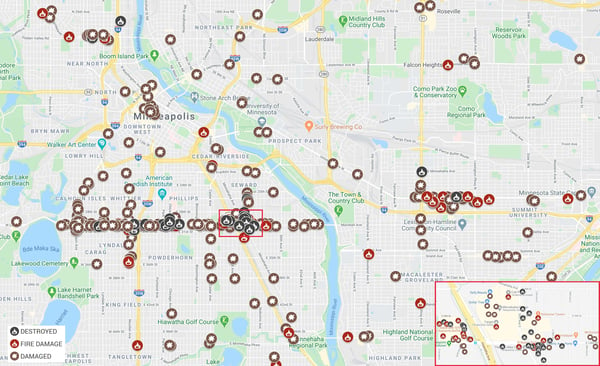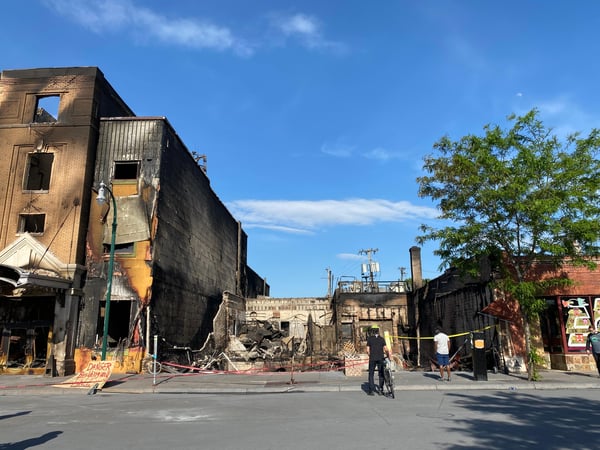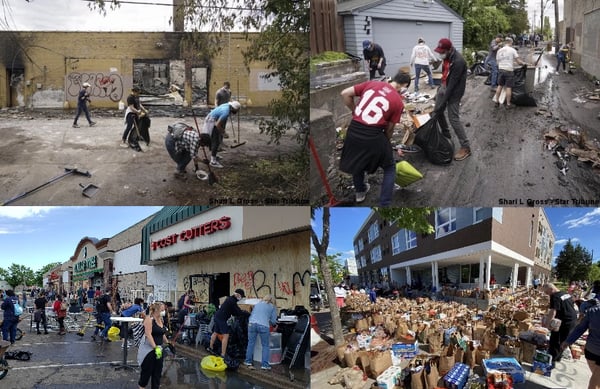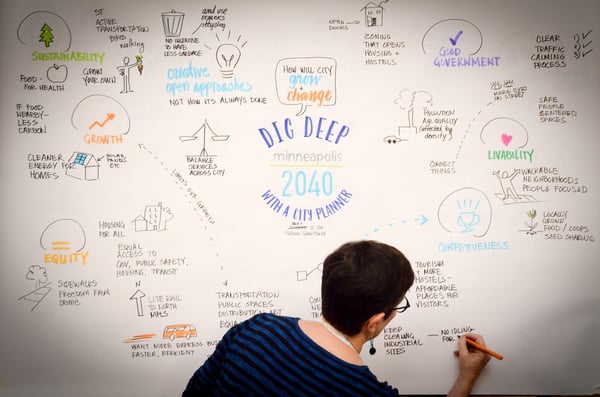For Riot-Damaged Twin Cities Businesses, Rebuilding Will Begin
There are two main business districts in the Twin Cities that were hit the hardest following the unrest that occurred between May 26th and May 30th, after the death of George Floyd. The first area is the South Minneapolis Lake Street corridor, stretching roughly 3 miles between Lyndale Avenue South and Minnehaha Avenue, and the other is in St. Pauls’ Midway district, along the University Avenue corridor between Snelling Avenue and Lexington Parkway. According to city officials, more than 1,500 properties across the Twin Cities were affected — ranging from minor damage to complete destruction. Based on community data, approximately 101 businesses sustained major fire and property damage and 66 businesses were fully destroyed.
 Map of Damage in South Minneapolis Lake Street corridor and St. Pauls’ Midway district, based on local community data and shown on a map provided by Google.
Map of Damage in South Minneapolis Lake Street corridor and St. Pauls’ Midway district, based on local community data and shown on a map provided by Google.
As BBJ Group’s Minneapolis employees surveyed the area along the Lake Street corridor, we saw empty lots where once thriving businesses were located, boarded storefronts, and several buildings reduced to rubble. Now, residents are taking stock of the physical damage left and wondering how the community can rebuild.
 Photo Credit: Tarek Aboueid.
Photo Credit: Tarek Aboueid.
As the conditions in Minneapolis have started to settle down, attention is now turning towards a time of unity and rebuilding for the areas that saw some of the worst damage during the unrest. Efforts to rebuild and help these businesses is essential to keep the spirit of the Twin Cities thriving, and volunteers have turned up by the thousands to help. We’ve seen firsthand that many members of the community are contributing to positive change in a myriad of ways, including: sweeping streets; removing trash, glass, and other debris; clearing out damaged stores; and donating food and other supplies to grocery desert areas. Additionally, we are already seeing huge outpouring of community support for the Lake Street area in terms of donations to local businesses or other organizations to get businesses on their feet again; for more information, a local news agency has assembled a list here: https://kstp.com/news).
 Photo Credit: Tarek Aboueid and Shari L. Gross of the Star Tribune
Photo Credit: Tarek Aboueid and Shari L. Gross of the Star Tribune
Hopefully we will see that these businesses in Minneapolis’ and St. Paul’s core districts are not gone for long. It is expected that small- to mid-sized community-owned businesses will require significant effort and a lot of capital to invest in repairs and redevelopment. The recovery process is anticipated to be driven by a combination of public, private, and charitable funds that can be leveraged to help with the investment needed for rebuilding. Critical factors for the ultimate success toward rebuilding include: 1) how much the community supports the idea of the community itself, 2) the continued patronage of businesses, and 3) investment in the future.
A Plan Toward a Better Future
As Minneapolis and the other affected communities find a way to rebuild, it represents an opportunity to find creative solutions to property redevelopment which may in the long-term strengthen our communities and help them make themselves more resilient and sustainable.
Specifically, for the City of Minneapolis, the rebuilding process is likely to be informed by Minneapolis 2040 - The City's Comprehensive Plan. This plan generally includes a broad vision for goals such as reducing carbon emissions, creating a more transit-friendly city, addressing racial and income inequality, and creating better redevelopment opportunities.
 Photo Credit: Minneapolis 2040.com
Photo Credit: Minneapolis 2040.com
Through its Minneapolis 2040 Plan, the City has embraced a new vision that would be community-driven and include some of the following:
- Ensuring access to employment, retail services, healthy food, parks, and other daily needs via walking, biking, and public transit;
- Placing emphasis on supporting the development, growth, and retention of small businesses;
- Keeping physical attributes of Minneapolis that reflect the city’s history and culture; and
- Properly identifying environmental concerns for development and construction.
Additionally, businesses will also have an opportunity to look at an accessible and greener future by considering Americans with Disabilities Act (ADA)-compliant, energy efficient, and environmentally sustainable approaches when they rebuild.
Unique Risks the Damage Represents and Environmental Challenges Associated with those Risks
In addition to the societal and economic costs of community rebuilding, the recent damage and destruction may have a range of less-obvious adverse consequences on the environment. This include air pollutants from smoke plumes, water runoff containing hazardous chemicals from various pollutants, and environmental discharges or releases from burned materials (e.g. lead, asbestos, heavy metals, or other chemicals) that may have potential longer-term impacts to the community. Companies that are looking toward rebuilding will have to consider new potential liabilities as well as the environmental and human health risks in order to protect building occupants, get real estate financing, and/or pursue potential grants for redeveloping properties (e.g., brownfields grants, economic development grants, etc.). These might include:
- Appropriate due diligence or “all appropriate inquiry” (e.g., Phase I Environmental Site Assessments).
- Hazardous material surveys;
- Environmental and human health risk assessments;
- Vapor intrusion risks to new and renovated buildings; or,
- Lead and asbestos removal.
Looking Forward
The Twin Cities will recover. The death of George Floyd, and this is a unique moment in history has deeply impacted us. However, as we are processing what is happening during this time, we are confident that our community will recover and once again, be as vibrant as ever.
We envision one of the keys to success will be embracing ideas that allow the affected communities to be rebuilt differently, better than before. This will involve businesses and their advisors, communities, and municipalities addressing the concerns of citizens who want their city healed as fast as possible, managing environmental challenges associated with the damage, and working to construct more sustainable buildings and businesses. As BBJ Group looks forward, we hope to use our resources to help the Twin Cities overcome these challenges and facilitate for changes to make all of our communities successful.



